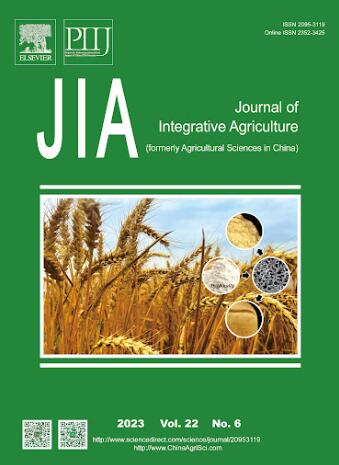Protein disulfide isomerase MoPdi1 regulates fungal development, virulence, and endoplasmic reticulum homeostasis in Magnaporthe oryzae1
IF 4.4
1区 农林科学
Q1 AGRICULTURE, MULTIDISCIPLINARY
引用次数: 0
Abstract
Rice blast, caused by ,is a fungal disease that causes devastating damage to rice production worldwide. During infection, pathogens secrete effector proteins that modulate plant immunity. Disulfide bond formation catalyzed by protein disulfide isomerases (PDI) is essential for protein folding and maturation. However, the biological function of Pdi1 in has not yet been characterized. In this study, we identified the endoplasmic reticulum (ER)-located protein, MoPdi1, in . MoPdi1 regulates conidiation, cell wall stress, and pathogenicity of . Furthermore, the CGHC active sites in the a and a’ redox domain of MoPdi1 were essential for the biological function of . Further tests demonstrated that MoPdi1 was involved in the regulation of ER stress and positively regulated ER phagy. We also found that MoPdi1 interacted with MoHut1. Deletion of led to the bereft of MoHut1 dimerization, which depends on the formation of disulfide bonds. In addition, MoPdi1 affected the normal secretion of the cytoplasmic effector AVR-Pia. We provided evidence that MoHut1 is important for the vegetative growth, conidiation, and pathogenicity in . Therefore, our findings could provide a suitable target point for designing antifungal agrochemicals against rice blast fungus.蛋白二硫异构酶 MoPdi1 调控木格鲁氏真菌的发育、毒力和内质网稳态1
稻瘟病是一种真菌病害,对全球水稻生产造成毁灭性破坏。在感染过程中,病原体会分泌调节植物免疫力的效应蛋白。蛋白质二硫键异构酶(PDI)催化的二硫键形成对蛋白质折叠和成熟至关重要。然而,Pdi1 的生物功能尚未确定。在这项研究中,我们发现了内质网(ER)定位蛋白 MoPdi1。此外,MoPdi1 的 a 和 a'氧化还原结构域中的 CGHC 活性位点对其生物功能至关重要。 进一步的试验证明,MoPdi1 参与了 ER 应激的调控,并对 ER 吞噬作用有正向调控作用。我们还发现 MoPdi1 与 MoHut1 相互作用。缺失MoPdi1会导致MoHut1失去二聚化,而二聚化依赖于二硫键的形成。此外,MoPdi1 还影响细胞质效应物 AVR-Pia 的正常分泌。我们提供的证据表明,MoHut1 对疟原虫的无性生长、分生孢子和致病性都很重要。因此,我们的发现可为设计抗稻瘟病真菌的农用化学品提供一个合适的靶点。
本文章由计算机程序翻译,如有差异,请以英文原文为准。
求助全文
约1分钟内获得全文
求助全文
来源期刊

Journal of Integrative Agriculture
AGRICULTURE, MULTIDISCIPLINARY-
CiteScore
7.90
自引率
4.20%
发文量
4817
审稿时长
3-6 weeks
期刊介绍:
Journal of Integrative Agriculture publishes manuscripts in the categories of Commentary, Review, Research Article, Letter and Short Communication, focusing on the core subjects: Crop Genetics & Breeding, Germplasm Resources, Physiology, Biochemistry, Cultivation, Tillage, Plant Protection, Animal Science, Veterinary Science, Soil and Fertilization, Irrigation, Plant Nutrition, Agro-Environment & Ecology, Bio-material and Bio-energy, Food Science, Agricultural Economics and Management, Agricultural Information Science.
 求助内容:
求助内容: 应助结果提醒方式:
应助结果提醒方式:


